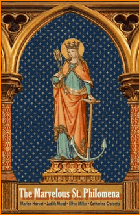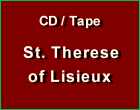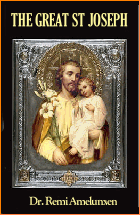Symbolism
 |
 |
 |
 |
 |
 |
 |
The Symbolism of the Passion Flower
Most of the rich symbols of the Passion of Our Lord have their roots in the Middle Ages, but there is one that comes from the American Continent. It is the Passiflora, passion fruit (in English), fruit de la passion (in French), fruta de la pasión (in Spanish) or flor-da-Paixão or flor de maracujá (in Portuguese).
 When the Spanish and Portuguese missionaries and explorers came to the Americas in the 16th century, they were charmed by the exuberant beauty and features of this perfumed flower and immediately associated it with elements of Christ's Calvary. The Jesuits named the flower Flos Passionis or Flor de las Cinco Llagas, Flower of the Five Wounds. They brought it back with them to Spain and later the fruit found its way to other parts of Europe and the world.
When the Spanish and Portuguese missionaries and explorers came to the Americas in the 16th century, they were charmed by the exuberant beauty and features of this perfumed flower and immediately associated it with elements of Christ's Calvary. The Jesuits named the flower Flos Passionis or Flor de las Cinco Llagas, Flower of the Five Wounds. They brought it back with them to Spain and later the fruit found its way to other parts of Europe and the world.
In the flower of this purple-colored fruit one can find many of the symbols of the Passion. For this reason the early Catholic missionaries saw it as a gift of God to help them in their work of teaching the Indians to understand the Passion of Christ and the Crucifixion. Even the flower color – mostly purple in hue – was remindful of the liturgical color of Lent. Let us look at the many symbols found in the Passion Flower:
• Its central pillar represents the column where Our Lord was so brutally flogged, and the many slender tendrils surrounding its base were likened to the cords and whips used in the Scourging.
• The three top stigma, each with a roughly rounded head, symbolize the three nails used to drive the spikes into Our Lord's flesh.
• The five anthers are symbolic of the five Sacred Wounds and the circle of filaments that compose the dramatic center of this flower represent the Crown of Thorns.
• The rays within the flower form a nimbus, representing Our Lord's divine glory.
 • The leaves on many of these plants are shaped like the spear that pierced His Heart.
• The leaves on many of these plants are shaped like the spear that pierced His Heart.
• The 10 petals represent the 10 apostles who forsook their Master and fled, omitting Judas, the traitor, and St. John, who remained with Our Lady under the Cross.
A symbolic meaning was found even for the often round shape of the passion fruit itself: it represents the sinful world that Christ came to save by the supreme Sacrifice of His life.
Our first sketch of this exotic plant is from a pamphlet dated 1609. The Dominican monk Simone Parlasca clearly sketched passion fruit vine, emphasizing the symbols of Christ's passion we find in the flower. One year later, another sketch by Eugenio Petrelli on the frontipiece in a book by Antonia Possevino, made the symbols even more distinct. This model was widely used in pamphlets of the time.
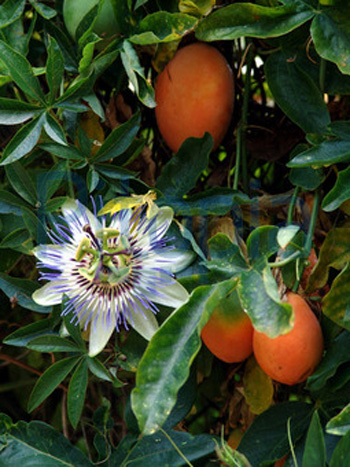 There are now believed to be more than 500 species of the Passion flower around the world, but mostly in Brazil. Some are edible, especially the most popular Passiflora edulis. Its fruit is eaten fresh or used in drinks, desserts, jams and ice creams. A vigorous and rapid climber, it supplies shade, color and nectar all year and is quite easy to grow.
There are now believed to be more than 500 species of the Passion flower around the world, but mostly in Brazil. Some are edible, especially the most popular Passiflora edulis. Its fruit is eaten fresh or used in drinks, desserts, jams and ice creams. A vigorous and rapid climber, it supplies shade, color and nectar all year and is quite easy to grow.
Roots and leaves of the passion flower were used by the South American Indians to make a tea with which they treated epilepsy, hysteria and insomnia. This tincture even had properties that helped to soothe pain.
The Europeans soon discovered the value of this marvelous plant and took up its use, especially for calming the nerves.
It is yet another symbolic aspect of the Passion Fruit: Like Christ who came to relieve the sufferings and anxieties of fallen man, so this marvelous plant relieves the angsts and pains of those who take advantage of the properties imbued in it by God the Creator.
The Passion Flower
Catulo da Paixão Cearense,
a popular Brazilian poet
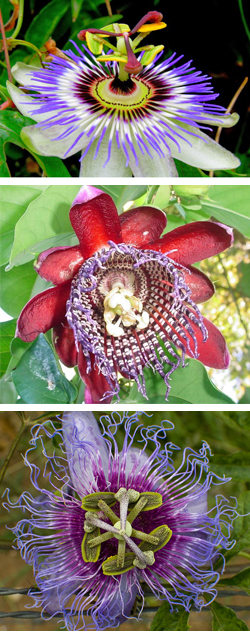
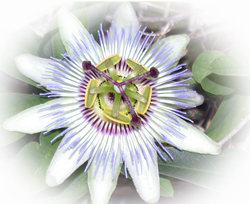 Finding myself with a backwoodsman
Finding myself with a backwoodsman
Near a foot of a passion fruit,
I asked him: Tell me, dear countryman,
Why was the passion flower born purple?
Now I will relate to you
The story that he told me.
The reason why the passion flower
Came to be purple.
The passion flower was once white
It could not be whiter,
Whiter than charity,
Whiter than the moonlight,
When the flowers bloomed in it
There in the corners of the backwoods
The passion fruit looked like
A nest of cotton.
But one day, long, long ago,
In a month lost in my memory,
If it was May, if it was June,
If it was January or December,
Our Lord Jesus Christ
Was condemned to die
Crucified on a Cross,
Far from here where Christ
Was nailed with a hammer.
And to see such cruelty
All of nature
Was weeping with sadness.
The fields wept,
The beech trees, the rivulets,
The songbirds also cried.
The crested jay, the orange tree.
And there, next to the Cross,
At its foot was a passion fruit
Filled with flowers
From the foot of Our Lord
The blood of Jesus Christ
Spilled down from above
Onto the passion fruit
And tinted all the flowers.
Behold here the story
I heard our young man tell
The reason why the passion flower
Was born purple.
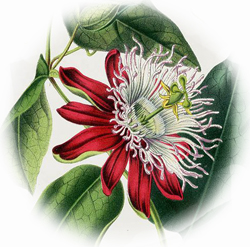


The passion flower has many symbols of Christ's Passion
In the flower of this purple-colored fruit one can find many of the symbols of the Passion. For this reason the early Catholic missionaries saw it as a gift of God to help them in their work of teaching the Indians to understand the Passion of Christ and the Crucifixion. Even the flower color – mostly purple in hue – was remindful of the liturgical color of Lent. Let us look at the many symbols found in the Passion Flower:
• Its central pillar represents the column where Our Lord was so brutally flogged, and the many slender tendrils surrounding its base were likened to the cords and whips used in the Scourging.
• The three top stigma, each with a roughly rounded head, symbolize the three nails used to drive the spikes into Our Lord's flesh.
• The five anthers are symbolic of the five Sacred Wounds and the circle of filaments that compose the dramatic center of this flower represent the Crown of Thorns.
• The rays within the flower form a nimbus, representing Our Lord's divine glory.

The Parlasca sketch of 1609, left, the Petrelli sketch at right
• The 10 petals represent the 10 apostles who forsook their Master and fled, omitting Judas, the traitor, and St. John, who remained with Our Lady under the Cross.
A symbolic meaning was found even for the often round shape of the passion fruit itself: it represents the sinful world that Christ came to save by the supreme Sacrifice of His life.
Our first sketch of this exotic plant is from a pamphlet dated 1609. The Dominican monk Simone Parlasca clearly sketched passion fruit vine, emphasizing the symbols of Christ's passion we find in the flower. One year later, another sketch by Eugenio Petrelli on the frontipiece in a book by Antonia Possevino, made the symbols even more distinct. This model was widely used in pamphlets of the time.

The fruit is borne on thick, fast growing vines
Roots and leaves of the passion flower were used by the South American Indians to make a tea with which they treated epilepsy, hysteria and insomnia. This tincture even had properties that helped to soothe pain.
The Europeans soon discovered the value of this marvelous plant and took up its use, especially for calming the nerves.
It is yet another symbolic aspect of the Passion Fruit: Like Christ who came to relieve the sufferings and anxieties of fallen man, so this marvelous plant relieves the angsts and pains of those who take advantage of the properties imbued in it by God the Creator.
Catulo da Paixão Cearense,
a popular Brazilian poet


A few of the many varieties of the Passion Flower
Near a foot of a passion fruit,
I asked him: Tell me, dear countryman,
Why was the passion flower born purple?
Now I will relate to you
The story that he told me.
The reason why the passion flower
Came to be purple.
The passion flower was once white
It could not be whiter,
Whiter than charity,
Whiter than the moonlight,
When the flowers bloomed in it
There in the corners of the backwoods
The passion fruit looked like
A nest of cotton.
But one day, long, long ago,
In a month lost in my memory,
If it was May, if it was June,
If it was January or December,
Our Lord Jesus Christ
Was condemned to die
Crucified on a Cross,
Far from here where Christ
Was nailed with a hammer.
And to see such cruelty
All of nature
Was weeping with sadness.
The fields wept,
The beech trees, the rivulets,
The songbirds also cried.
The crested jay, the orange tree.
And there, next to the Cross,
At its foot was a passion fruit
Filled with flowers
From the foot of Our Lord
The blood of Jesus Christ
Spilled down from above
Onto the passion fruit
And tinted all the flowers.
Behold here the story
I heard our young man tell
The reason why the passion flower
Was born purple.


Posted March 28,, 2018
______________________
______________________




